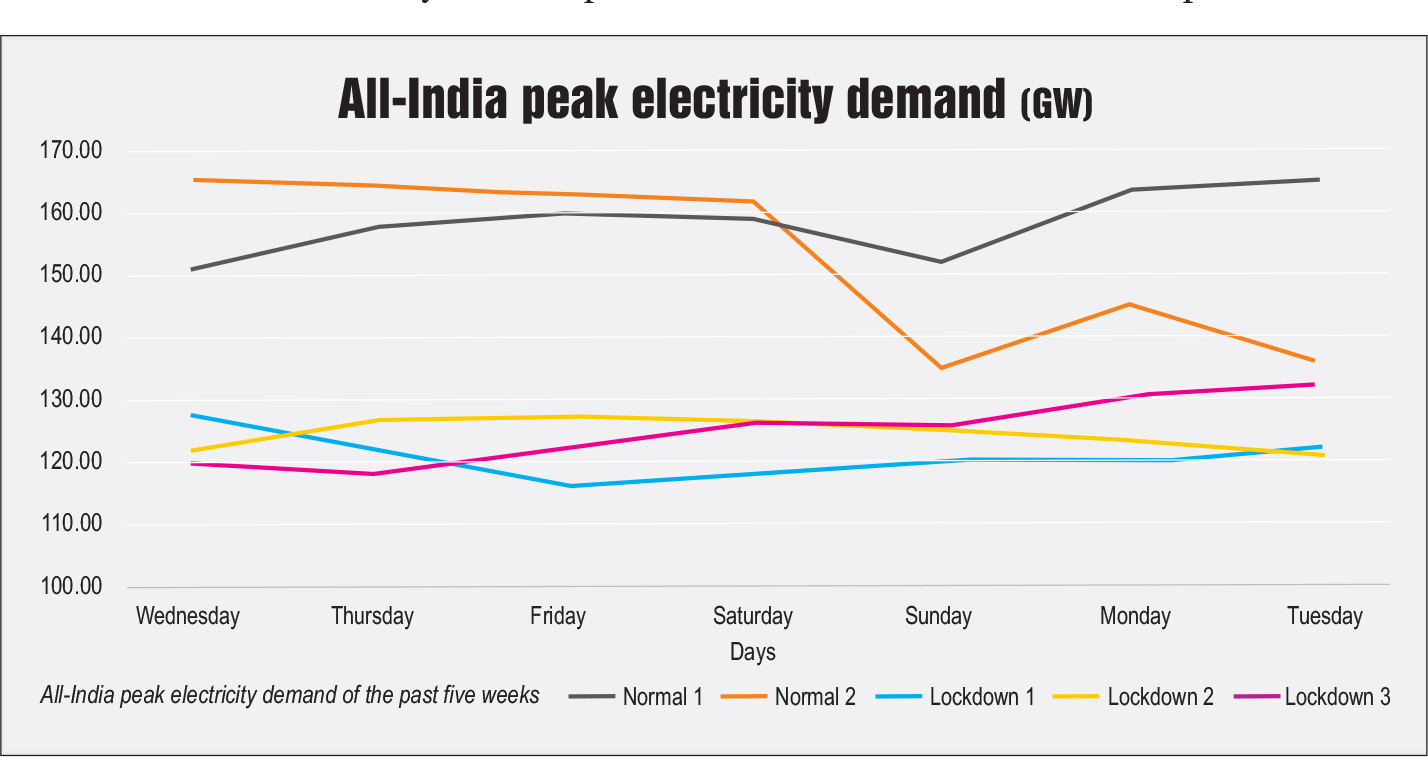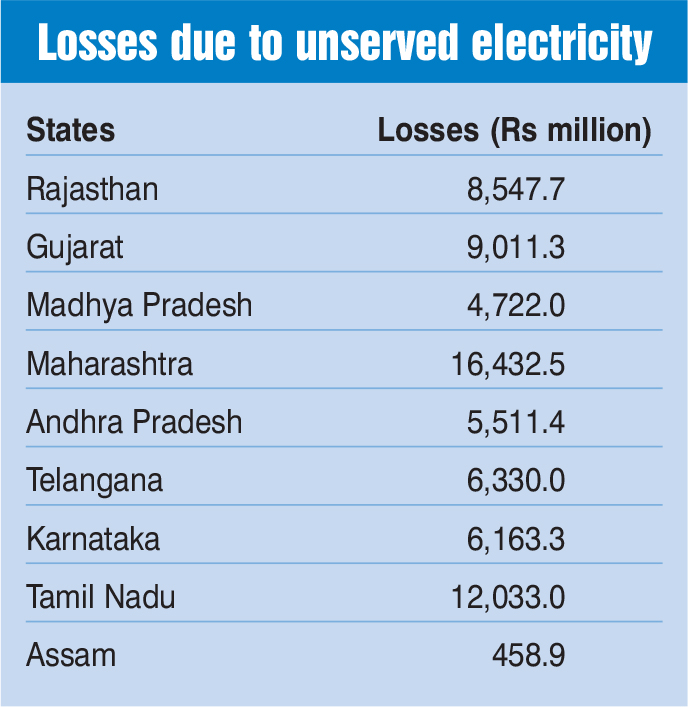 By DrBalasubramanian S., Researcher, Indian Institute of Science, Bangalore
By DrBalasubramanian S., Researcher, Indian Institute of Science, Bangalore
The 21-day lockdown (Phase I) announced by the Indian government to contain the spread of Covid-19, is now over, but the government has extended it further with some riders. During Phase I of the shutdown spanning three weeks, from March 25, 2020 to April 14, 2020, all major economic activities were halted, which reduced electricity demand across the country.
Status of all-India peak electricity demand
The week starting March 11, 2020 to March 17, 2020 is considered as normal week 1 in the analysis. The week from March 18, 2020 to March 24, 2020 is considered as normal week 2. The week from March 25, 2020 to March 31, 2020 is considered as lockdown week 1, from April 1, 2020 to April 7, 2020 as te lockdown week 2, and from April 8, 2020 to April 14, 2020 as lockdown week 3.
All-India peak electricity demand of the last five weeks
The average peak demand in normal week 1 was around 158 GW, whereas the average peak demand in normal week 2 reduced to 153 GW, which can be attributed to Janta curfew and the preparation for the national shutdown. However, the average peak demand dropped to 121 GW, 124 GW and 124 GW in lockdown weeks 1, 2 and 3 respectively. In comparison with normal week 1, the percentage reduction in peak demand was around 24 per cent (lockdown week 1) and 22 per cent (lockdown weeks 2 and 3). In absolute terms, on an average, there was a daily reduction in peak demand of about 35 GW. The average peak demand in all the five electricity regions of India during lockdown weeks was less than that in normal week 1. The highest average reduction in peak demand in northern region (NR) was experienced in lockdown week 1 at 20 per cent. Interestingly, the average peak demand show ed an increasing trend during the lockdown weeks in NR, western region (WR) and eastern region (ER). During the same period, the average peak demand in southern region (SR) and north-eastern region (NER) showed a decreasing trend.
 Electricity consumption
Electricity consumption
A total energy consumption of 23,851 GWh was recorded in normal week 1. It reduced to 18,659 GWh (22 per cent decrease) in lockdown week 1. Even though janta curfew was observed in normal week 2, the energy consumption was 23,378 GWh. As compared to normal week 1, there was a reduction in energy consumption of 19 per cent (19,833 GWh) and 18 per cent (20,146 GWh) in lockdown weeks 2 and 3 respectively. At the end of lockdown week 3, there was an increasing trend in electricity consumption and demand, which is expected to increase in the coming days even with the extended lockdown. This can be attributed to the change in climatic conditions.
 Northern region
Northern region
On an average, NR accounts for 24 per cent of all India electricity consumption. The electricity consumption in normal week 1 was around 5,387 GWh. It reduced by 21 per cent during lockdown week 1 to stand at 4,269 GWh. The corresponding reduction in lockdown weeks 2 and 3 was 15 per cent (4,572 GWh) and 8 per cent (4,879 GWh) respectively. In lockdown week 3, there was a significant increase in electricity consumption in NR. The total electricity consumption in Rajasthan was 1,404 GWh, which reduced to 933 GWh (34 per cent), 1,035 GWh (26 per cent) and 1,105 GWh (21 per cent) in lockdown weeks 1, 2 and 3, respectively. However, the electricity consumption in Uttar Pradesh was 1,528 GWh and increased to 1,592 GWh, 1,697 GWh and 1,870 GWh in lockdown weeks 1, 2 and 3 respectively, a corresponding increase of 4 per cent, 11 per cent and 22 per cent respectively. Notably, the only state to show an increase in electricity consumption during these three weeks was Uttar Pradesh.
Rajasthan witnessed a steep decline of about 35 per cent in peak demand in lockdown week 1, from 11.5 GW to 7.5 GW. In the next two lockdown weeks, the peak demand reduction was around 30 per cent and 28 per cent respectively. However, Uttar Pradesh reported an increase in peak demand during lockdown weeks, the only state in NR to have such a peculiar scenario. In the three lockdown weeks, the peak demand in Uttar Pradesh increased by 5 per cent, 16 per cent and 23 per cent, respectively. The peak demand in Uttar Pradesh during normal week 1 was 12.5 GW and it increased to 13.2 GW, 14.4 GW and 15.3 GW in lockdown weeks 1, 2 and 3 respectively.
Eastern region
The region accounts for nearly 10 per cent of all India electricity consumption. The total electricity consumption in ER during normal week 1 was around 2,471 GWh and it reduced to 2,298 GWh, 2,355 GWh and 2,425 GWh in lockdown weeks 1, 2 and 3 respectively, a corresponding reduction of 7 per cent, 5 per cent and 2 per cent. In ER, West Bengal accounted for 40 per cent of the total electricity consumed in the region. The total electricity consumption in the state was around 884 GWh in normal week 1 and reduced to 841.6 GWh in lockdown week 1, a reduction of 5 per cent. In the next two lockdown weeks, the total electricity consumption increased by 7 per cent (950 GWh) and 9 per cent (965 GWh) respectively. In normal week 1, the average peak demand in West Bengal was around 7.3 GW and it reduced to 6.5 GW, 6.9 GW and 7.1 GW in lockdown weeks 1, 2 and 3 respectively, a corresponding reduction of 11 per cent, 6 per cent and 2 per cent. Even though the total energy consumption in the state increased, its peak demand was below the prevailing average.
North-eastern region
The total electricity consumption of NER was just 1 per cent of all-India electricity consumption. In normal week 1, the total electricity consumption in NER was around 286 GWh and it reduced to 249 GWh, 239 GWh and 237 GWh in the lockdown weeks 1, 2 and 3 respectively. The major electricity consuming state in NER was Assam with a 55 per cent share. With respect to electricity consumption in normal week 1, the total electricity consumption in Assam was around 161 GWh, which reduced to 142 GWh, 140 GWh and 130 GWh in the three lockdown weeks. The electricity consumption witnessed a decreasing trend in the state during the lockdown weeks at around 12 per cent, 13 per cent and 19 per cent respectively. The state’s peak demand in normal week 1 was around 1.40 GW. It reduced to 1.28 GW, 1.26 GW and 1.24 GW in lockdown weeks 1, 2 and 3 respectively, a reduction of 8 per cent, 10 per cent and 11 per cent.
Western region
WR accounts for nearly 33 per cent of all India electricity consumption. In the region, the total electricity consumption in normal week 1 was around 7,898 GWh and it reduced to 5,536 GWh in lockdown week 1, 5,986 GWh in lockdown week 2 and 6,310 GWh in lockdown week 3, a corresponding reduction of 30 per cent, 24 per cent and 20 per cent. In Gujarat, the electricity consumption in lockdown week 1 reduced by 811 GWh from normal week 1, a reduction of 36 per cent. The corresponding reduction in lockdown weeks 2 and 3 was 661 GWh (29 per cent) and 531 GWh (23 per cent). In Madhya Pradesh, the reduction in electricity consumption was around 358 GWh, 249 GWh and 180 GWh in lockdown weeks 1, 2 and 3 respectively, a corresponding reduction of 25 per cent, 18 per cent and 13 per cent. However, the highest reduction was experienced in Maharashtra at 940 GWh (28 per cent) in lockdown week 1, 751 GWh (22 per cent) in lockdown week 2 and 656 GWh (19 per cent) in lockdown week 3.
The highest reduction in average peak demand in Gujarat was experienced in lockdown week 1 at 36 per cent, that is, the average peak demand reduced from 15.27 GW in normal week 1 to 9.8 GW in lockdown week 1. The corresponding reduction in average peak demand in Madhya Pradesh was 25 per cent, a reduction from 10.38 GW to 7.78 GW. However, the average peak demand of Maharashtra was 23.02 GW in normal week 1 and it reduced to 16.24 GW in lockdown week 1, a reduction of 29 per cent. In lockdown weeks 2 and 3, the average peak demand in Gujarat was 10.5 GW and 11.11 GW, respectively while in Madhya Pradesh it was 8.7 GW and 8.9 GW. The average peak demand of Maharashtra in lockdown weeks 2 and 3 was 17.2 GW and 17.6 GW, respectively. From the second week of the lockdown, both the electricity consumption and peak demand saw an increasing trend. However,They were still well below the consumption and peak demand levels of normal week 1.
Southern region
On an average SR, constitutes 32 per cent of all India electricity consumption. In the region, more than 90 per cent of electricity consumption was from the states of Andhra Pradesh, Telangana, Karnataka and Tamil Nadu at around 18 per cent, 22 per cent, 24 per cent and 30 per cent respectively. The total electricity consumption in SR during normal week 1 was around 7,810 GWh and it reduced to 6,307 GWh in lockdown week 1 and it further reduced to 6,188 GWh and 5,689 GWh in lockdown weeks 2 and 3, respectively.
 The total electricity consumption in all the SR states follows a decreasing trend in the three lockdown weeks. For example, in Andhra Pradesh, the total electricity consumption in normal week 1 was around 1,390 GWh and it reduced to 1,131 GWh, 1,124 GWh and 1,049 GWh in lockdown weeks 1, 2 and 3, respectively. In Telangana, the total electricity consumption in normal week 1 was 1,662 GWh and it reduced to 1,436 GWh (14 per cent) in lockdown week 1, 1,319 GWh (21 per cent) in lockdown week 2 and 1,176 GWh (29 per cent) in lockdown week 3. In Karnataka, the consumption reduced by 15 per cent, 16 per cent and 23 per cent, respectively. In normal week 1, Karnataka’s total consumption was 1,777 GWh, which reduced to 1,516 GWh in lockdown week 1, 1,499 GWh in lockdown week 2 and 1,369 GWh in lockdown week 3.
The total electricity consumption in all the SR states follows a decreasing trend in the three lockdown weeks. For example, in Andhra Pradesh, the total electricity consumption in normal week 1 was around 1,390 GWh and it reduced to 1,131 GWh, 1,124 GWh and 1,049 GWh in lockdown weeks 1, 2 and 3, respectively. In Telangana, the total electricity consumption in normal week 1 was 1,662 GWh and it reduced to 1,436 GWh (14 per cent) in lockdown week 1, 1,319 GWh (21 per cent) in lockdown week 2 and 1,176 GWh (29 per cent) in lockdown week 3. In Karnataka, the consumption reduced by 15 per cent, 16 per cent and 23 per cent, respectively. In normal week 1, Karnataka’s total consumption was 1,777 GWh, which reduced to 1,516 GWh in lockdown week 1, 1,499 GWh in lockdown week 2 and 1,369 GWh in lockdown week 3.
However, in SR, the highest reduction in energy consumption was experienced by Tamil Nadu. In normal week 1, the total consumption was 2,350 GWh and it reduced to 1,723 GWh, 1,718 GWh and 1,603 GWh in the three lockdown weeks, a corresponding reduction by 27 per cent, 27 per cent and 32 per cent. Even the peak demand saw a significant reduction in all these four states. The highest peak demand reduction was experienced by Tamil Nadu, where the average peak demand reduced from 15 GW in normal week 1 to 10 GW in lockdown week 3, recording a 31 per cent reduction.
 Revenue losses
Revenue losses
The total monetary losses of various discoms during these three weeks are expected to be around Rs 80 billion. Maharashtra is expected to have the highest losses of Rs 16.43 billion, followed by Tamil Nadu at Rs 12.03 billion, Gujarat at Rs 9.01 billion and Rajasthan at Rs 8.54 billion. With the lockdown extended till May 3, more losses have been predicted and it will take some time before the sector can recover.
Generation and carbon emissions reduction
During normal week 1, the percentage of coal in the total generation was around 72 per cent, which reduced to around 66 per cent in the lockdown weeks. In normal week 1, the generation from coal was 17,401 GWh and it reduced to 12,456 GWh in the lockdown week 1, 13,029 GWh in lockdown week 2 and 13,321 GWh in lockdown week 3. With the reduction in coal power generation in these three weeks, there was an avoided carbon emission of close to 13.30 million tonnes. Meanwhile, generation from renewables remained at the same level. So, the lockdown was helpful in reducing CO2 emissions but at a huge cost.
 Summary
Summary
The most interesting observation is that electricity demand in three regions followed an increasing trend both in terms of electricity consumption and peak demand during the lockdown weeks. However, in the four major states in SR, both the electricity consumption and peak demand witnessed a decreasing trend during this period even though this is the summer season in Southern India.
Another interesting observation was that electricity consumption was higher in the states of Uttar Pradesh and West Bengal during the lockdown weeks as compared to the normal weeks. This may be due to the climatic conditions and the greater number of households in these two heavily populated states. The considerable reduction in electricity consumption and peak demand experienced in the states of Maharashtra, Gujarat and Tamil Nadu can be attributed to the high industrial demand in these places. Due to this lockdown, every sector has experienced severe monetary losses and the electricity sector is no exception. The majority of the losses due to energy not served were experienced by the discoms of Maharashtra, Tamil Nadu and Gujarat.



